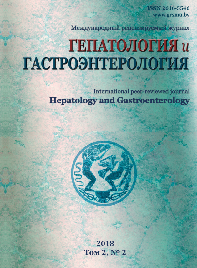ПАРЭХОВИРУСНАЯ ИНФЕКЦИЯ У ПАЦИЕНТОВ С ИНФЕКЦИОННОЙ ПАТОЛОГИЕЙ ЖЕЛУДОЧНО-КИШЕЧНОГО ТРАКТА И МОЛЕКУЛЯРНО-ГЕНЕТИЧЕСКАЯ ХАРАКТЕРИСТИКА ВОЗБУДИТЕЛЕЙ

Аннотация
Введение. Парэховирусы (ПЭВ) – широко распространенные РНК-содержащие вирусы, обнаруживаемые у пациентов с инфекционными заболеваниями пищеварительной системы. Системных исследований по проблеме парэховирусной инфекции в Республике Беларусь ранее не было, данные о ее распространенности и о циркулирующих возбудителях отсутствовали.
Цель исследования – анализ результатов генодиагностики ПЭВИ у пациентов с инфекционной патологией желудочно-кишечного тракта и изучение молекулярно-генетических характеристик ее возбудителей.
Материал и методы. Исследован клинический материал от 276 пациентов с признаками кишечной инфекции, собранный в 2016-2018 гг. Детекцию ПЭВ осуществляли методом ОТ-ПЦР-РВ, генотипирование – методом секвенирования участка гена VP1 ПЭВ.
Результаты. По результатам проведенной генодиагностики парэховирусная инфекция выявлена у 4,7% обследованных пациентов. Все генотипированные изоляты принадлежали 1 типу. Заключение. В этиологическую структуру регистрируемых в Республике Беларусь кишечных вирусных инфекций определенный вклад вносят ПЭВ. Среди выявленных возбудителей кишечной формы парэховирусной инфекции идентифицированы ПЭВ 1 типа, которые характеризовались значительной гетерогенностью своей популяции.
Литература
1. Olijve L, Jennings L, Walls T. Human Parechovirus: an Increasingly Recognized Cause of Sepsis-Like Illness in Young Infants. Clin. Microbiol. Rev. 2017;31(1):e00047-17. doi:10.1128/CMR.00047-17.
2. Parechovirus [Internet]. Available from: http://www icornaviridae.com/parechovirus/parechovirus.htm.
3. Shah G, Robinson JL. The particulars on parechovirus. Can. J. Infect. Dis. Med. Microbiol. 2014;25(4):186-188.
4. Strenger V, Diedrich S, Boettcher S, Richter S, Maritschnegg P, Gangl D, Fuchs S, Grangl G, Resch B, Urlesberger B. Nosocomial Outbreak of Parechovirus 3 Infection among Newborns, Austria, 2014. Emerg. Infect. Dis. 2016;22(9):1631-1634. doi: 10.3201/eid2209.151497.
5. Ljubin-Sternak S, Juretić E, Šantak M, Pleša M, Forčić D, Vilibić-Čavlek T, Aleraj B, Mlinarić-Galinović G. Clinical and molecular characterization of a parechovirus type 1 outbreak in neonates in Croatia. J. Med. Virol. 2011;83(1):137-141. doi: 10.1002/jmv.21848.
6. Aizawa Y, Suzuki Y, Watanabe K, Oishi T, Saitoh A. Clinical utility of serum samples for human parechovirus type 3 infection in neonates and young infants: The 2014 epidemic in Japan. J. Infect. 2016;72(2):223-232. doi: 10.1016/j.jinf.2015.10.010.
7. Biscaro V, Piccinelli G, Gargiulo F, Ianiro G, Caruso A, Caccuri F, De Francesco MA. Detection and molecular characterization of enteric viruses in children with acute gastroenteritis in Northern Italy. Infect. Genet. Evol. 2018;60:35-41. doi: 10.1016/j.meegid.2018.02.011.
8. Golitsyna LN, Zverev VV, Novikova NA, Fomina SG, Parfenova OV, Epifanova NV, Lukovnikova LB, Morozova OV, Ponomareva NV. Obnaruzhenie, osobennosti cirkuljacii i raznoobrazie parjehovirusov cheloveka v Nizhnem Novgorode [Prevalence, Features of Circulation, and Diversity of Human Parechoviruses in Nizhny Novgorod]. Voprosy virusologii [Problems of Virology]. 2013;58(2):29-33. (Russian).
9. Baumgarte S, de Souza Luna LK, Grywna K, Panning M, Drexler JF, Karsten C, Huppertz HI, Drosten C. Prevalence, Types, and RNA concentrations of human parechoviruses, including a sixth parechovirus type, in stool samples from patients with acute enteritis. J. Clin. Microbiol. 2008;46(1):242-248. doi:10.1128/JCM.01468-07.
10. Nix WA, Maher K, Johansson ES, Niklasson B, Lindberg AM, Pallansch MA, Oberste MS. Detection of all known parechoviruses by real-time PCR. J. Clin. Microbiol. 2008;46(8):2519-2524. doi: 10.1128/JCM.00277-08.
11. Nix WA, Maher K, Pallansch MA, Oberste MS. Parechovirus typing in clinical specimens by nested or semi-nested PCR coupled with sequencing. J. Clin. Virol. 2010;48(3):202-207. doi: 10.1016/j.jcv.2010.04.007.
12. Tamura K, Stecher G, Peterson D, Filipski A, Kumar S. MEGA6: Molecular Evolutionary Genetics Analysis version 6.0. Mol. Biol. Evol. 2013;30(12):2725-2729. doi: 10.1093/molbev/mst197.
13. Altschul SF, Gish W, Miller W, Myers EW, Lipman DJ. Basic local alignment search tool. J. Mol. Biol. 1990;215(3):403-410. doi: 10.1016/S0022-2836(05)80360-2.
14. Moe N, Pedersen B, Nordbø SA, Skanke LH, Krokstad S, Smyrnaios A, Døllner H. Respiratory Virus Detection and Clinical Diagnosis in Children Attending Day Care. PLoS One. 2016;11(7):e0159196. doi: 10.1371/journal.pone.0159196.
15. Ljubin-Sternak S, Marijan T, Ivković-Jureković I, Čepin-Bogović J, Gagro A, Vraneš J. Etiology and Clinical Characteristics of Single and Multiple Respiratory Virus Infections Diagnosed in Croatian Children in Two Respiratory Seasons. J. Pathog. 2016;2016:2168780. doi: 10.1155/2016/2168780.
16. Tapia G, Cinek O, Witsø E, Kulich M, Rasmussen T, Grinde B, Rønningen KS. Longitudinal observation of parechovirus in stool samples from Norwegian infants. J. Med. Virol. 2008;80(10):1835-1842. doi: 10.1002/jmv.21283.
17. Zhang DL, Jin Y, Li DD, Cheng WX, Xu ZQ, Yu JM, Jin M, Yang SH, Zhang Q, Cui SX, Liu N, Duan ZJ. Prevalence of human parechovirus in Chinese children hospitalized for acute gastroenteritis. Clin. Microbiol. Infect. 2011;17(10):1563-1569. doi: 10.1111/j.1469-0691.2010.03390.x.

















2.png)






